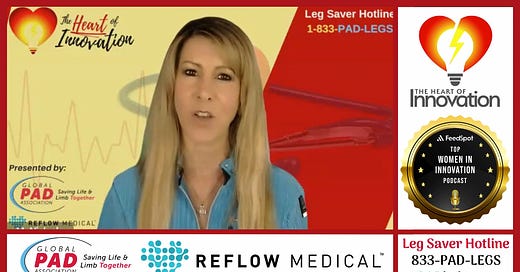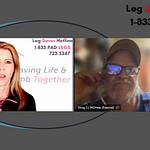If you’re living with poor circulation in your legs (peripheral artery disease or PAD) and also struggle with knee arthritis, you know the cruel dilemma: You need to walk to improve your circulation, but your knee pain makes walking unbearable.
I’ve heard this story countless times from PAD Warriors in our community. Doctors tell you walking is essential medicine – it helps your body build natural bypasses around blockages in your leg arteries. But with every step feeling like knives in your knee, how can you possibly follow this advice?
Even worse, many of you have been told you’re not a good candidate for knee replacement due to other health issues like diabetes, kidney disease, or heart problems. You’re left in a painful limbo with few options.
But there’s hope in the form of a minimally invasive procedure that could be a game-changer for people caught in this exact situation.
What is Genicular Arterial Embolization (GAE)?
I recently interviewed two pioneering doctors performing a procedure called Genicular Arterial Embolization (GAE) on The Heart of Innovation: Dr. Osman Ahmed, an interventional radiologist, and Dr. Sid Rao, who has performed over 700 of these procedures.
In simple terms, GAE targets the root cause of knee pain: inflammation.
Dr. Ahmed explained it beautifully: “We take a very small catheter, put it into an artery, find where those areas of inflammation are in the knee, and block the abnormal blood flow that’s feeding the inflammation.”
What makes this different from other treatments? It’s:
Minimally invasive (no large incisions)
Outpatient procedure (usually go home the same day)
Quick recovery (many patients walk out the same day)
Targets only the abnormal blood vessels causing inflammation
Preserves your normal healthy blood vessels
Unlike knee replacement, which requires months of painful rehabilitation, many GAE patients resume walking immediately. Dr. Rao’s patients often experience significant pain relief within days to weeks.
Is This Right for Me?
GAE isn’t for everyone. It works best for:
People with mild to moderate knee arthritis (not severe “bone-on-bone” cases)
Those who aren’t good candidates for knee replacement
Patients who have tried physical therapy, steroid injections, or other conservative treatments without relief
Those looking to delay inevitable knee replacement
This procedure is particularly valuable if you have PAD and need to walk as part of your treatment, but knee pain is stopping you.
Questions to Ask Your Doctor
If you think GAE might help you, here are key questions to ask your doctor:
“Have you heard of Genicular Arterial Embolization for knee arthritis?”
Many doctors, especially in rural areas, may not be familiar with this newer procedure.“Could my knee pain be making my PAD worse because I can’t walk?”
Make sure your doctor understands how these conditions affect each other.“Am I a candidate for knee replacement? If not, why?”
Understanding why you’re not a surgical candidate helps determine if GAE is appropriate.“Would you refer me to an interventional radiologist or cardiologist who performs GAE?”
These specialists are most likely to offer this procedure.“Could we treat both my PAD and my knee arthritis?”
Some specialists, like Dr. Rao, treat both conditions in the same sitting.“What’s causing my knee pain? Is it primarily inflammation?”
GAE works best when inflammation is the main cause of pain.“How might this help my overall circulation and health?”
Remember, walking is critical for your vascular health.
Breaking the “Lose Weight First” Cycle
One of the most frustrating things I hear from our community is being told, “Just lose weight, and then we’ll treat your knee.”
As Dr. Michael Ginsburg pointed out during our interview: “They can’t lose weight because they can’t walk as their knees hurt, but they can’t get treatment for what prevents them from walking in the first place.”
This impossible cycle traps too many patients. GAE could potentially break this cycle by reducing knee pain enough to allow for increased activity, which then supports weight management.
Finding a Doctor Who Performs GAE
GAE isn’t yet widely available, but it’s becoming more accessible. Here’s how to find a qualified specialist:
Call our leg saver hotline at 1-833-PAD-LEGS (1-833-723-5347)
Our team can help you find specialists in your area who perform GAE.Search online for “genicular artery embolization” plus your city (SirWeb.org has a great doctor finder that allows you to specify treatments)
Doctors performing this procedure often advertise it on their websites.Ask for a referral to an interventional radiologist, interventional cardiologist, or vascular surgeon
These specialists are most likely to offer GAE.
The good news: Medicare now covers GAE for beneficiaries who aren’t candidates for knee replacement, which has greatly improved access.
What to Expect During the Procedure
If you’re considering GAE, here’s what to expect:
Preparation: You’ll likely need to stop certain medications before the procedure.
The procedure: Takes about 30-45 minutes and is typically performed under moderate sedation (you’re awake but comfortable).
Access: The doctor will access your arteries either through a small puncture in your groin or through your foot.
Imaging: Special x-rays with contrast dye show where inflammation is occurring.
Embolization: Tiny particles are injected to block only the abnormal blood vessels.
Recovery: Most patients go home the same day and can resume light activities immediately.
Results: Pain relief typically begins within days to weeks and can last for months to years.
Real Patient Experiences
Next week on The Heart of Innovation, I’ll be featuring Jose, who weighed 600 pounds and had both PAD and knee arthritis. Doctors told him they couldn’t help until he lost weight – but how could he lose weight when he couldn’t walk?
His story highlights why we need options like GAE that can break these impossible cycles and create paths forward for patients who’ve been told “there’s nothing more we can do.”
My Personal Take
As someone who’s worked with thousands of PAD patients, I believe the most valuable treatments aren’t those that replace what’s already working – they’re the ones that create options where none existed before.
If you’re caught between PAD and knee pain, and conventional approaches have failed you, don’t give up hope. Reach out to our Global PAD Association through our leg saver hotline at 1-833-PAD-LEGS. We can help connect you with specialists who understand the challenges of managing multiple conditions and may offer innovative options like GAE.
Remember: You deserve treatment options that address your unique situation, not one-size-fits-all approaches that leave you suffering in the gaps between specialties.
Have you had GAE or are you considering it? I’d love to hear your experience in the comments.
To learn more about GAE and other treatments for PAD, visit theheartofinnovation.org or contact our leg saver hotline at 1-833-PAD-LEGS (1-833-723-5347).













Share this post